 This month we have another dirty water science experiment. Our goal is to test different types of homemade water filters. Imagine if you had a natural disaster that compromised the local water supply. This is a real possibility for many people who live in hurricane and storm-prone areas. In such an emergency, your only source of water may not be safe to drink. If you don’t have a supply of clean water, would you be able to improvise and use common household materials to filter water to make it safe to drink? For this science project, testing homemade water filters, all you need is a School and Science Fair Test Kit from TestAssured, some dirty water, and a few common household items for filters. We decided to use a paper towel, cotton, and a microfiber cloth as our filters.
This month we have another dirty water science experiment. Our goal is to test different types of homemade water filters. Imagine if you had a natural disaster that compromised the local water supply. This is a real possibility for many people who live in hurricane and storm-prone areas. In such an emergency, your only source of water may not be safe to drink. If you don’t have a supply of clean water, would you be able to improvise and use common household materials to filter water to make it safe to drink? For this science project, testing homemade water filters, all you need is a School and Science Fair Test Kit from TestAssured, some dirty water, and a few common household items for filters. We decided to use a paper towel, cotton, and a microfiber cloth as our filters.
Supplies
The first thing you need to do is gather your supplies:
- Test Assured 4 Test Kit Set with TDS Meter
- 4 cups
- Dirty water (we added some dirt from the backyard to regular tap water)
- Assorted items that can be used as filters (paper towels, old rags, washcloths, coffee filters, anything porous that could filter out dirt while allowing the water to seep through)
Preparation
To prepare for the tests, you’ll need some dirty water. We scooped up some dirt from the yard and added it to tap water. Be sure to stir the mixture well.

Next you’ll need to set up your filters to create the different samples you will be testing. We used a metal strainer and lined it with the different items we were using as filters.
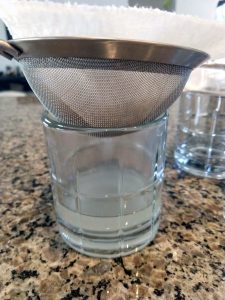
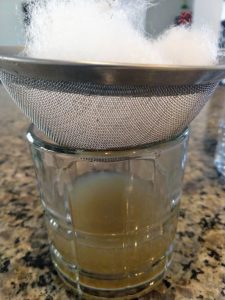
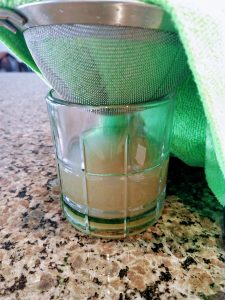
Make sure that you stir the dirty water frequently so the dirt doesn’t settle to the bottom. You want to make sure that each sample is the same before it goes through your filters. Don’t forget to fill one cup with plain tap water that has not been filtered. This will be the control that the other samples are measured against.
Now is a good time to label your vials and list your different samples in the results notebook.
Testing
First, you will start with the test for total dissolved solids, using the TDS meter. Because the meter will not fit in the test vials, it is easier to complete this part of the experiment while your samples are still in the cups. To perform the TDS test, simply turn on the meter and submerge the prongs in the samples. Rinse the meter with clean water between each test. Record your results in the results notebook. Be sure to read the TDS meter carefully. High readings will be noted with “x10.” We were surprised to find that our control sample had a higher TDS reading that some of our filtered samples.
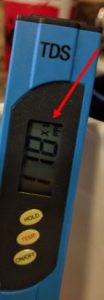
After completing the TDS test, you will need to pour your samples into the vials you labeled. Do this over a sink and be sure to wipe up any spills, so you don’t contaminate the test strips.
Before you get started with the tests, now is a good time to make some visual observations. Take notes about how clear or cloudy your samples look. Are there any visible particles floating in any of the samples? Write your observations in the “Notes” on the last page of the results notebook. For our samples, it was very obvious that the paper towel seemed to work the best as that filtered sample was not nearly as brown as the others.
Now you’re ready to get started with the rest of the tests. It’s easiest to work with one sample at a time. Follow these instructions to complete the remaining tests.
Alkalinity/pH/Hardness Test
- Remove the test strip from the packet labeled, “ALK/pH/Hard”
- Pick up the strip on the end with no pads
- Dip the strip in the sample for one second and remove
- Hold the test strip level and wait 10 seconds
- Place the strip as shown in the picture and compare to the color chart for alkalinity, pH, and harness
- Record your results in the results notebook
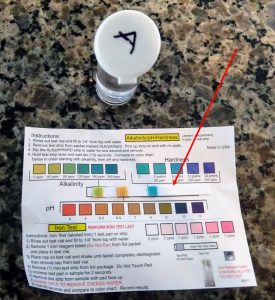
Total Chlorine/Copper/Nitrate/Nitrite Test
- Remove the test strip from the packet labeled, “CL/CO/NA/NI”
- Pick up the strip on the end with no pads
- Dip the strip in the sample three times and remove – DO NOT SHAKE OFF EXCESS WATER
- Hold the test strip level for 2 seconds
- Place the strip as shown in the picture and compare to the color chart for chlorine and copper
- Wait 45 seconds before reading the results for nitrate and nitrite
- Record your results in the results notebook
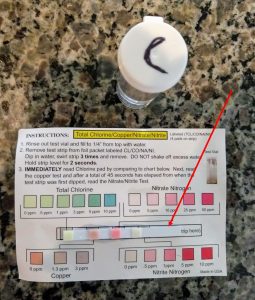
Iron Test (Complete this test last)
- Remove one iron reagent tablet from the foil packet and place in test vial (the reagent could alter the results of other tests which is why the iron test is completed last)
- Place the cap on the test vial and shake for approximately one minute, until the tablet is completely dissolved
- Remove the test strip from the packet labeled, “Iron Test”
- Dip the strip in the sample for 2 seconds
- Shake the strip once and wait 60 seconds
- Place the strip as shown in the picture and compare to the color chart for iron
- Record your results in the results notebook
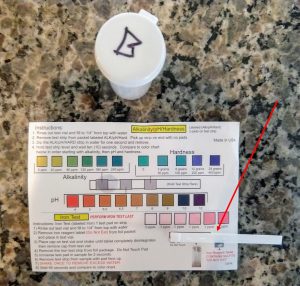
Repeat all three tests for each of your samples. Make sure you wash your hands with soap and water when you are finished.
Results
Now that you have completed each of the tests on your four samples, it’s time to look at your results. Ask yourself these questions:
- How did the control sample differ from your other samples
- Did any of the filters you used work better than others?
- Do you think you could rely on a homemade water filter in an emergency?
- What do you think would happen if you combined all of your filters?
- What results did you find the most surprising?
Record your answers on the “Notes” page. If you are doing a science project, create a graph to show your results. You can also use clear tape to fix the test sticks to the color charts to display your results.


